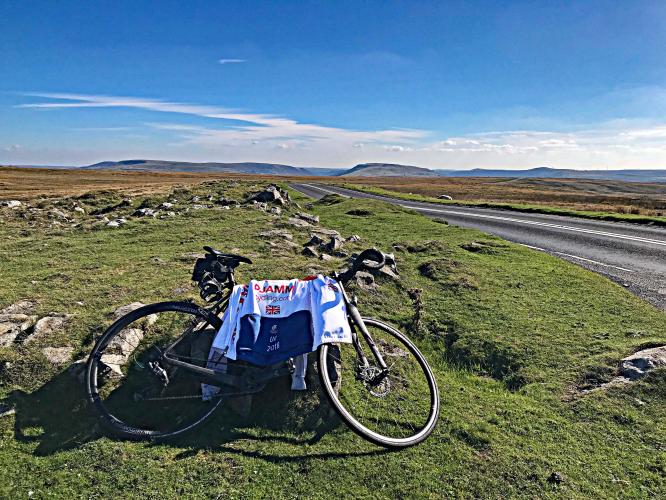Llangynidir Mountain Climb Summary
![Llangynidir Mountains #94 Simon Warren 100 Greatest Cycling Climbs Cycling Llangynidir Mountains #94 Simon Warren 100 Greatest Cycling Climbs - aerial drone photo - road and hills; 100 Greatest Cycling Climbs logo]()
View west from 3.5 kilometers up the climb
The climb begins just past the eastern edge of Llangynidr by riding up the B4560 from its intersection with Cyffredyn Lane. The first 3.7 kilometers average 8% grade and take us through 2 hairpins. Just past the second hairpin, there is a 370 meter descent followed by the final 1.1 kilometers at 7.4% to the climbs finish on a treeless flat stretch of highway.
![Llangynidir Mountains #94 Simon Warren 100 Greatest Cycling Climbs]()
First half of the climb is bordered by brush and hedge.
![Llangynidir Mountains #94 Simon Warren 100 Greatest Cycling Climbs Bike climb Llangynidir Mountains #94 Simon Warren 100 Greatest Cycling Climbs - aerial drone photo - road and fields]()
Pastures, rolling hills and views of the valley below..
![Llangynidir Mountains #94 Simon Warren 100 Greatest Cycling Climbs Biking Llangynidir Mountains #94 Simon Warren 100 Greatest Cycling Climbs - road at top]()
Finish isn’t much to speak of.
For the first half of the climb the road is bordered by hedge and pasture land which gives way to open views of rolling hills and valleys below as we ascend.
![]()
Steepest ½ kilometer begins at km 2.3 (9.5%)
This is one of the top bike climbs in Wales and is within 12 km of The Tumble to the southeast and at the southeastern edge of Brecon Beacons National Park. Simon Warren refers to it as a “monster climb” (100 Greatest Cycling Climbs, Britain, p. 161).
This climb is in the eastern section of Brecon Beacons National Park, Wales, 134,420 hectares (332,160 acres), established 1957:
“The Brecon Beacons National Park was established in 1957, the third of the three Welsh parks after Snowdonia in 1951 and the Pembrokeshire Coast in 1952. It stretches from Llandeilo in the west to Hay-on-Wye in the northeast and Pontypool in the southeast, covering 519 square miles (1,340 km2) and encompassing four main regions – the Black Mountain in the west, reaching 802 metres (2631 feet) at Fan Brycheiniog, Fforest Fawr and the Brecon Beacons in the centre, including the highest summit in the park and in South Wales at Pen y Fan 886 metres (2,907 feet) and the confusingly named Black Mountains in the east, where the highest point is Waun Fach 811 metres (2,661 feet). The western half gained European and Global status in 2005 as Fforest Fawr Geopark. This includes the Black Mountain, the historic extent of Fforest Fawr, and much of the Brecon Beacons and surrounding lowlands.
The entire National Park achieved the status of being an International Dark Sky Reserve in February 2013.
Most of the National Park is bare, grassy moorland grazed by Welsh mountain ponies and Welsh mountain sheep, with scattered forestry plantations, and pasture in the valleys. It is known for its remote reservoirs, waterfalls including the 90-foot (27 m) Henrhyd Waterfall and the falls at Ystradfellte, and its caves, such as Ogof Ffynnon Ddu. The Brecon Beacons Mountain Centre was opened in 1966 to help visitors understand and enjoy the area.
Due to the relative remoteness and harsh weather of some of its uplands, the Park is used for military training. UK Special Forces, including the SAS and SBS hold demanding selection training exercises here, such as an exercise called the Fan dance. The infantry regiments of the British Army train at Sennybridge, where NCO selection also takes place.
In 2006 and 2007, controversy surrounded the government decision to build the South Wales Gas Pipeline through the Park, the National Park Authority calling the decision a ‘huge blow’.” Wikipedia - Brecon Beacons National Park

 We've partnered with Sherpa-Map.com to bring you the best route planning tool. With a PRO Membership you can use this climb as a reference when creating your route.
We've partnered with Sherpa-Map.com to bring you the best route planning tool. With a PRO Membership you can use this climb as a reference when creating your route. 

